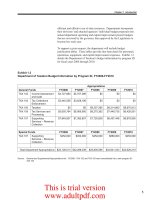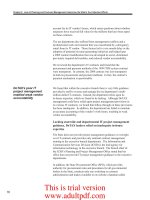05 tax planning
Bạn đang xem bản rút gọn của tài liệu. Xem và tải ngay bản đầy đủ của tài liệu tại đây (595.01 KB, 52 trang )
Personal Finance: Another Perspective
Tax
Planning
Updated 1/18/2012
1
Objectives
• A. Understand what our leaders have said
regarding taxes
• B. Understand the importance of tax planning
and how it helps attain your personal goals
• C. Understand the tax process
• D. Understand strategies to help lower your
taxes (legally and honestly)
• E. Understand the major tax features of our tax
system
2
Your Personal Financial Plan
• Section V.: Taxes
• What Tax Form and Tax Strategies did
you use last year?
• What was your marginal and average
tax rates?
• Action Plan:
• What Tax Form and Tax Strategies should you
use this year?
• What else can and should you do to reduce
your tax bill to Uncle Sam (for a given level
of income)?
3
A. Understand our Leaders
Counsel on Taxes
• The Lord has said:
• Let no man break the laws of the land, for he
that keepeth the laws of God hath no need to
break the laws of the land. Wherefore, be
subject to the powers that be, until he reigns
whose right it is to reign, and subdues all
enemies under his feet (D&C 58:21-22).
• The 12th Article of Faith states:
• We believe in being subject to kings,
presidents, rulers, and magistrates, in
obeying, honoring, and sustaining the law.
4
Our Leaders Counsel (continued)
• Some have tried to minimize this obligation.
President Harold B. Lee instructed:
• There seem to be those among us who are as
wolves among the flock, trying to lead some who
are weak and unwary, . . . who are taking the law
into their own hands by refusing to pay their
income tax (Ensign, January 1973, p. 106).
• In the April 1973 Priesthood Bulletin the Church
reaffirmed its position stating:
• We ask priesthood leaders to be on guard against
such persons. . . Priesthood leaders should teach
the necessity of abiding the law according to the
revelations (Priesthood bulletin, April 1973).
5
Questions
• Any questions about what our leaders
have said about paying taxes?
6
B. Understand How Tax Planning can
help attain your Personal Goals
• Why tax planning?
• Taxes are your largest single annual expense
• The average American works more than 4
months just to pay his or her taxes
• In sum: the less you pay Uncle Sam (for a
given level of income), the more you have for
your personal and financial goals!
7
Tax Freedom Day 1967-2010
8
•
Source: Tax Foundation, Washington, D.C., January 18, 2012.
The Impact of Taxes
Goals
Budget
Cash
Management
Estate
Planning
Taxes
Savings
and Debt
Retirement
Planning
Investing
Insurance
9
Questions
• Any questions on the impact of taxes and
your personal goals?
10
C. Understand the Federal Tax Process
and Strategies to Reduce Taxes
1. Start with
Income from
All Sources less
Exclusions,
Deferrals and
Losses = Gross
Income
2. Subtract
Adjustments to
Gross Income =
Adjusted Gross
Income (AGI)
3. Subtract the
greater of
Standard or
Itemized
Deductions
4. Minus
Exemptions
= Taxable
Income
5. Look up tax
on tax table =
Tentative Tax
6. Minus Credits
= Total Tax
Owed
7. Minus Taxes
already Paid =
Balance Due or
Amount of
Refund
11
Definitions
• 1. Gross Income
• Gross income for tax purposes is all income, unless
specifically excluded or deferred
• Exclusions include certain employer provided
fringe benefits, gifts and inheritances, beneficiaries
of life insurance proceeds, scholarships or grants
not in excess of college expenses, municipal bond
interest, and interest for education savings vehicles
used for education
• Deferrals include contributions, interest and
earnings on qualified retirement accounts
• Losses include net capital losses (up to $3,000),
sole proprietorship losses, and active participation
real estate losses
12
Definitions (continued)
• 2. Adjustments
• Adjustments are deductions from total income
allowed by the IRS to get your Adjusted Gross
Income (AGI). These include (among others):
• Qualified medical savings contributions
(flexible spending accounts)
• Health savings account contributions
• Student loan interest and tuition and fees
deduction (IRS 970) (within limits)
• One-half self employment tax, etc.
13
Definitions (continued)
• 3. Standard Deductions
• Deductions are IRS allowed reduction amounts
(standard deduction) or taxpayer determined
amounts (itemized deductions) to get taxable
income from your AGI
• Year
Standard Deduction (MFJ)
• 2008
10,900
• 2009
11,400
• 2010
11,400
• 2011
11,600
• 2012
11,900
14
Definitions (continued)
• 3. Itemized Deductions
• Allowable deductions (if you itemize) include:
• Charitable contributions (cash, in kind, and/or
mileage)
• Home mortgage interest
• Medical expenses (>7.5% AGI),
• Un-reimbursed qualified job expenses (> 2%
AGI),
• Casualty and theft expenses (> 10% AGI),
• Either state and local taxes or state and local
general sales taxes, property taxes on principle
residence, etc.
15
Definitions (continued)
• Mileage deduction vary depending on usage:
• Charitable mileage deductions
• 2010
.140 per mile
• 2011
.140 per mile
• 2012
.140 per mile
• Business mileage deductions
• 2010
.500 per mile
• 2011
.510 per mile
• 2012
.550 per mile
• Moving or medical mileage expense deductions
• 2010
.165 per mile
• 2011
.190 per mile
• 2012
.230 per mile
16
Definitions (continued)
• 4. Exemptions
• An exemption is an amount of money set by the
government that you can deduct for each qualifying
person in your household. If you are married with
4 young children still at home, you have 6
exemptions
• Year
Exemption Amount ($)
• 2008
3,500
• 2009
3,650
• 2010
3,650
• 2011
3,700
• 2012
3,800
6
Definitions (continued)
• 5. Tax Tables (married filing jointly [Schedule Y-1])
Year
2010
If Taxable
income is over
0 $16,750
$16,750 $68,000
But not
over
Tax
is
0
1,675
10%
15%
$68,000 $137,300 9,363
2011
0
16,750
25%
68,000
$137,300 $209,250 26,688 28%
137,300
$0 $17,000
17,000 69,000
$0
1,700
69,000 139,350
2012
Plus this Of the
percentage Excess
10%
15%
$0
17,000
9,500
25%
69,000
139,350 212,300 27,088
28%
139,350
0 17,400
17,400 70,700
70,700
0
1,740
142,700
10%
15%
0
17,400
9,735
25%
70,700
142,700 217,450 27,735
28%
142,700
18
Definitions (continued)
• 6. Credits
• Credits are dollar for dollar reductions in your
taxable liability. Credits are worth significantly
more than deductions.
• Credits are either refundable (paid to the taxpayer
even if the amount of the credits exceeds the tax
liability) or non-refundable
• Refundable credits include reductions for earned
income, taxes withheld on wages, estimated
income tax payments
• Non-refundable credits include child tax, child
and dependent care, elderly and disabled,
adoption, hope learning, and lifetime learning
19
Definitions (continued)
• Tax Credits for Students (income limits apply)
• Earned Income Tax Credit. This is available to lowincome individuals
• American Opportunity Tax Credit. Temporary credit,
which provides up to $2,500, 100% of the first $2,000
and 25% of the next $2,000
• Lifetime Learning Credit. You can get up to $2,000,
20% of the first $10,000 of expenses, even if you are
part-time
• Tuition and Fees Deduction. You may also claim an
education tax deduction instead of a college tuition tax
credit, up to $4,000 off your income
20
D. Understand Strategies to Minimize Tax
Payments for a Given Level of Income
Four key strategies:
1. Maximize Deductions
• Key Suggestions
• Use your home as a tax shelter
• Shift and bunch your deductions to get maximum
benefit in a specific year
• Continue to give, with tithes and offerings
• Keep good records of all other charitable
contributions, including mileage and in-kind
donations
• Keep good records of health and moving expenses
21
Tax Planning Strategies (continued)
2. Minimize Taxes Owed
• Key Suggestions
• Maximize long-term capital gains
• Taxes are not paid until the assets are sold
• Long-term capital gains rates are taxed less
than earned income (in some cases as much
as 20% less - 35% versus 15%).
• Emphasize stock dividends over bond interest
• Stock dividends have a 15% preferential tax rate
• Utilize a buy and hold strategy on financial assets
• You pay no taxes until you sell
22
• Manage your portfolio in a tax-efficient basis.
Tax Planning Strategies (continued)
3. Receive Tax-Exempt Income
• Key Suggestions
• Look to tax-free investments
• Municipal bond interest is federal-tax free, and
may be state and local tax-free as well
• Treasury securities are state tax-free
• Use Medical Savings Accounts (also called flexible
spending accounts) to pay medical bills with beforetax dollars and to reduce income
• Donate to charities with appreciated assets. That
way you do not pay capital gains taxes on the
appreciated assets
23
Tax Planning Strategies (continued)
4. Defer Taxes to the Future or Eliminate Taxes
• Key Suggestions
•
•
•
Defer taxes to the future by investing in
401k/403b/457 and other tax-deferred qualified
retirement plans, especially if they are matched
Eliminate future taxes by investing in Roth
retirement vehicles (Roth IRA, Roth 401k, etc.)
Prepare for future education expenses and
eliminate future taxes by investing in education
savings vehicles (i.e., 529 Plans and Education
IRAs) which eliminate future taxes on earnings
if the assets are used for qualified educational
expenses (exclusions)
24
Tax Recommendations
for Soon to be Graduating Students
•
1. Be organized with your record keeping
•
•
Have a folder that you put all your tax receipts into
for tax time—keep it current
Use an electronic system such as Quicken or
Mint.com to organize your finances
• These programs make taxes easier if you use
them as they help you remember when and
where you made tax-deductible contributions
25









